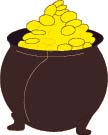

Goals:
To demonstrate their understanding of measurement terms used on the map.
To make connections to literature from their own activity.
Content Areas:
Math - conversions of measurement terms
Literature - introduction to Treasure Island
Materials:
Hidden treasures (include things like rocks painted like gold, candy, pencils, etc.)
Large open area (park, playground, school, etc.)
Rulers or meter sticks
Stevenson, Robert Louis. (1924). Treasure Island. Chicago: Winston. - copies needed
Procedure: (2 hours)
2) Divide the class into small groups.
3) Set the boundaries in which students will be searching for their treasure.
4) In groups, students search for their treasure.
5) After each group has found their treasure, bring the students back to the classroom and introduce the book Treasure Island.
6) Students, at this time, will write a short prediction about the book Treasure Island in their journals.
7) Read aloud the first section of Treasure Island, approximately the first fifty pages of the book. The class may follow along if each student has a copy.
8) Students will write a journal entry recording their predictions for the rest of the book. Each journal entry must be at least two paragraphs long and must contain at least two predictions.
Assessment:
Extensions:
In place of writing a prediction in their journals, students may draw a picture of an event(s) that they think will occur within the story.
![]()
Making Waves - written by Jennifer Cannistra, Jamie Hanna, Michael LeRoy, & Kim Mongoven
This page was submitted by St. Norbert College Ocean Voyagers Program